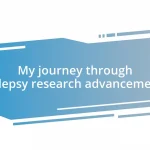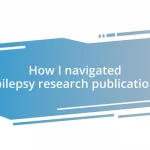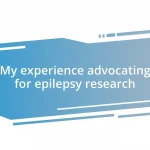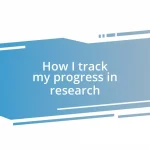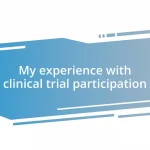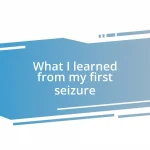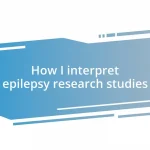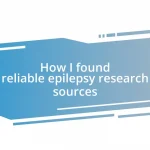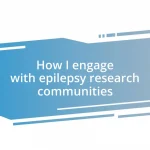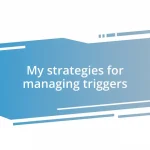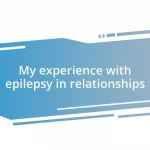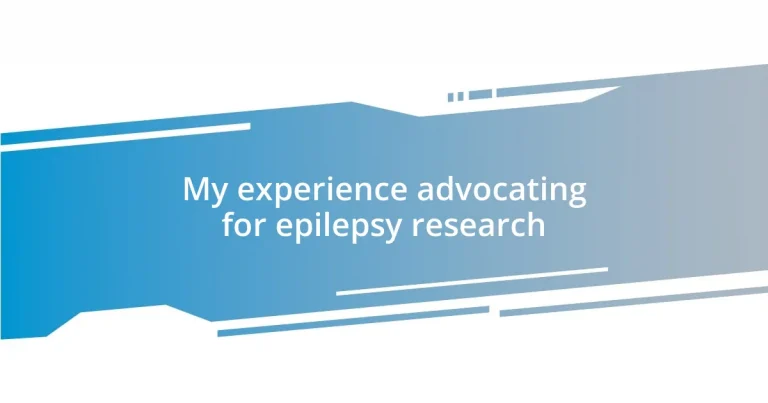Key takeaways:
- Epilepsy significantly impacts daily life, creating emotional challenges for both individuals and their families, necessitating a strong focus on advocacy and understanding.
- Research is essential for developing better treatments and reducing the stigma associated with epilepsy, as it helps combat misconceptions and fosters awareness.
- Personal experiences and community engagement, such as sharing stories and participating in support groups, empower advocacy efforts and create a sense of collective resilience.
- Effective advocacy strategies include storytelling, collaboration with local businesses, and educational initiatives to engage and inform the broader community about epilepsy.
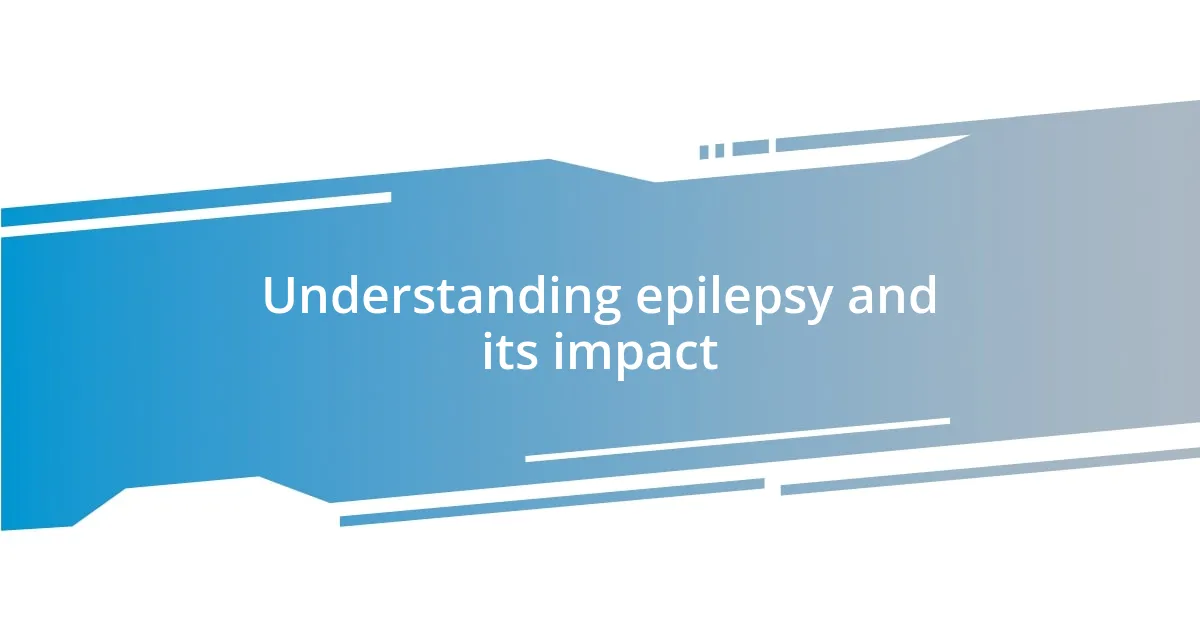
Understanding epilepsy and its impact
Epilepsy, a neurological disorder affecting millions worldwide, often comes with a heavy emotional toll. When I first learned my loved one had epilepsy, I was flooded with questions: How will this change our lives? What if a seizure occurs when no one is around? These fears highlighted the deep impact of epilepsy, not just on those diagnosed, but also on their families and friends who share in the uncertainty.
Living alongside someone with epilepsy teaches you to be constantly aware. I remember a specific moment when we were out at a café—her eyes suddenly blanked, and I watched panic grip the room as I rushed to her side. In that instant, I grasped how epilepsy can disrupt ordinary moments, pulling one into a world where preparedness meets vulnerability. It’s a stark reminder of how this condition shapes daily experiences, turning even simple outings into tests of vigilance.
Understanding epilepsy requires acknowledging that it’s more than just a medical condition; it’s a lens through which life is perceived and approached. The recurring question of “will it happen again?” often looms in the background, a persistent shadow, affecting not only the individual but everyone in their orbit. In sharing these experiences, I want to convey just how profound this impact can be, reminding us of the vital importance of advocacy and research in offering hope.
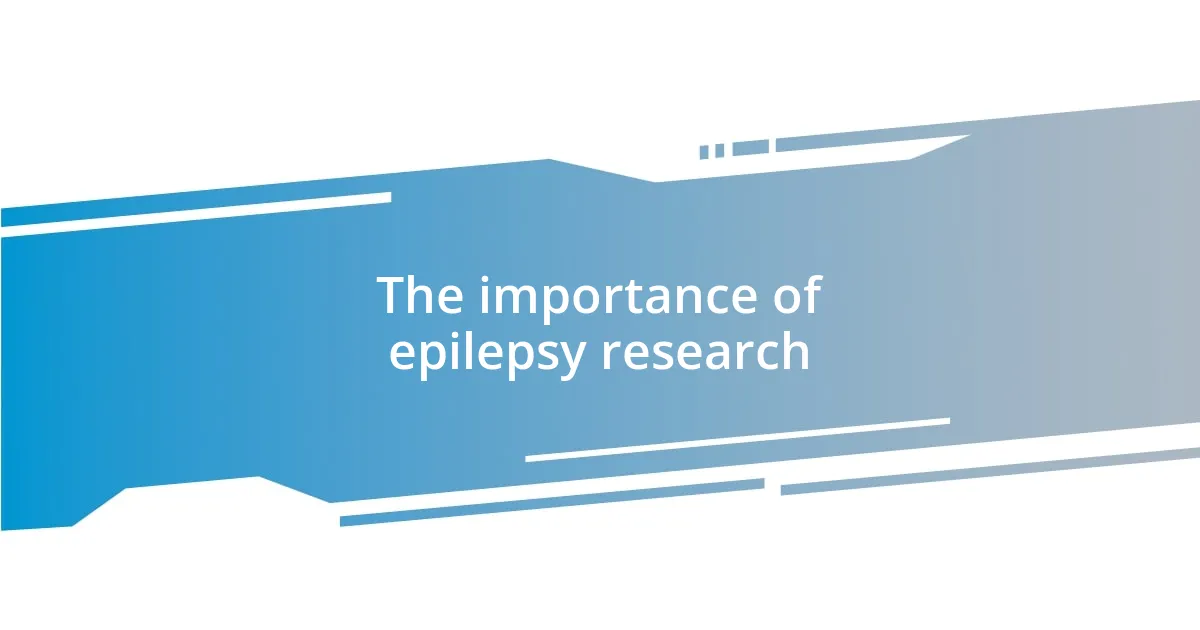
The importance of epilepsy research
Research into epilepsy is crucial as it opens doors to better treatments and, ultimately, a cure. I’ve witnessed firsthand how a lack of understanding about epilepsy can lead to stigma and misconceptions. When I participated in a community gathering, I could feel the tension when a discussion about seizures arose. People’s reactions varied from fear to outright avoidance, illustrating how essential it is to foster knowledge through research. Education can empower patients and families, reducing the social isolation they often experience.
The financial burden of epilepsy is another aspect that cannot be overlooked. It struck me when a friend shared her struggles with medical bills because treatment options were limited. The ongoing research is vital for developing more effective, affordable medications that can ease the strain on families like hers. Each study, each funded project represents hope for countless individuals who deserve better quality of life.
Moreover, the emotional landscape of living with epilepsy is often overshadowed by the clinical aspects. On one occasion, witnessing a child’s first seizure was heart-wrenching; the fear in the parent’s eyes is something I will never forget. It illuminated the need for comprehensive research that not only addresses seizure control but also considers the psychological impacts on both patients and their families. This holistic approach is what makes research indispensable.
| Aspect | Impact |
|---|---|
| Understanding | Enhances awareness, reduces stigma |
| Treatment Options | More effective and affordable solutions |
| Emotional Support | Aids in addressing psychological effects |
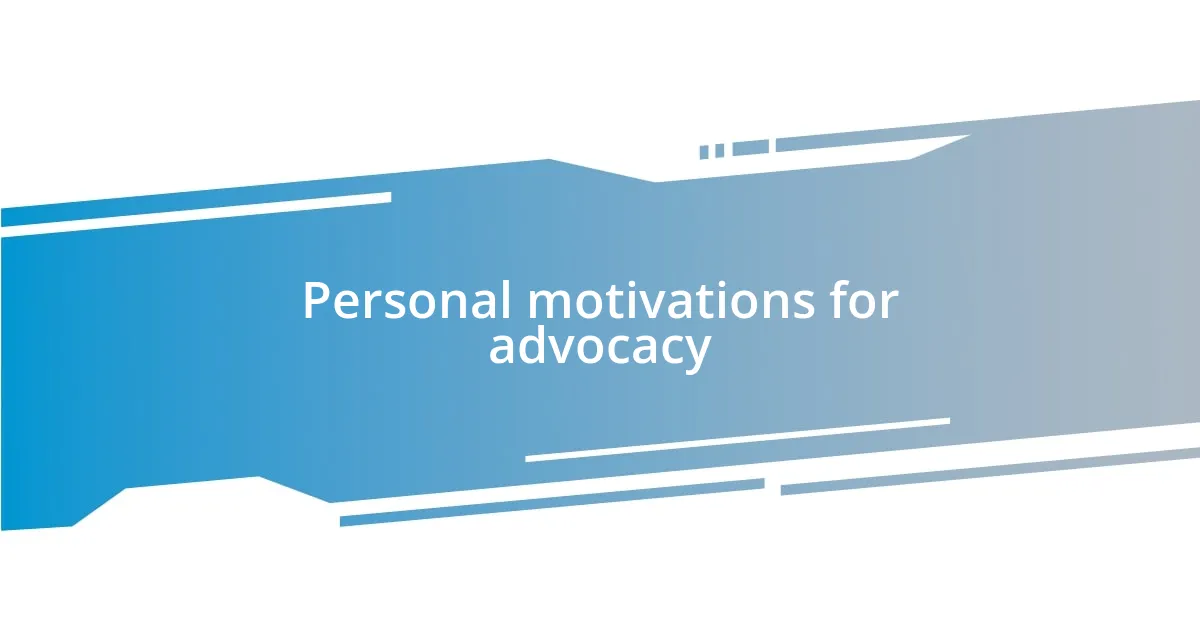
Personal motivations for advocacy
One of my driving motivations for advocacy stems from the personal impact epilepsy has had on my loved ones and myself. The first time my friend experienced a seizure during a public event was a catalyst for my passion; her rising panic and my helplessness ignited a deep desire within me to advocate for awareness and understanding. This eye-opening experience underscored how vital it is to illuminate the realities of living with epilepsy, transforming fear into informed support.
- Witnessing family and friends grapple with fear has pushed me to put a face to this condition.
- I often think about moments that never should have inspired anxiety—like going to the movies or taking a walk—yet they now carry the weight of vigilance.
- I find solace in knowing that with every conversation and effort in advocacy, I can contribute to dismantling the stigma surrounding epilepsy.
Equally important is the realization that advocacy fosters connection and community. There was a heartwarming moment at a local support group when a timid parent stood up to share her story. As I watched her emotions unfold, I recognized how crucial it is for families to have a safe space for their fears and triumphs. Every shared experience builds a tapestry of resilience that strengthens our collective voice in the call for research and support.
- Community support creates a sense of belonging that eases the isolating burden of living with epilepsy.
- Seeing how sharing stories empowers others reaffirms my belief that advocacy is about amplifying voices that often go unheard.
- I’ve learned that together, we can cultivate an environment where vulnerability is met with compassion and understanding, igniting meaningful change.
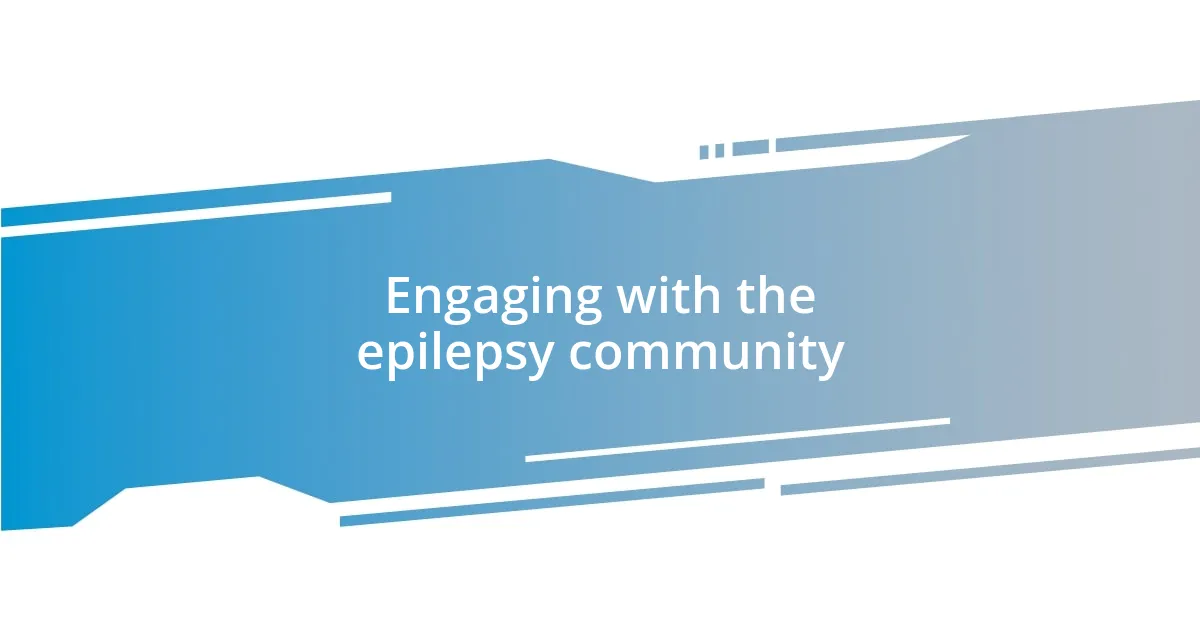
Engaging with the epilepsy community
Engaging with the epilepsy community has been a transformative journey for me. I vividly recall my first involvement in an epilepsy awareness walk. The atmosphere was electric, filled with individuals and families who shared their stories and struggles. I couldn’t help but feel a profound connection with everyone around me, realizing we were all united by a common purpose: to shine a light on epilepsy and advocate for those who face it daily.
In my experience, participating in local support groups has been just as rewarding. One evening, I sat next to a mother who was brave enough to discuss her child’s challenges. Listening to her made me reflect on the power of shared experiences. How many parents, like her, silently carry the weight of worry? These gatherings remind us that we’re not alone and allow us to exchange advice, hope, and encouragement, creating a safe haven for vulnerability.
One of the most powerful ways I’ve seen engagement flourish is through social media platforms. I remember posting about my advocacy efforts and was amazed by the flood of stories pouring in from across the globe. It struck me—what if we could connect every voice? Each story, each connection strengthens our community and sends a robust message: we are a force for change, demanding increased research and understanding about epilepsy. Isn’t that a message worth spreading?
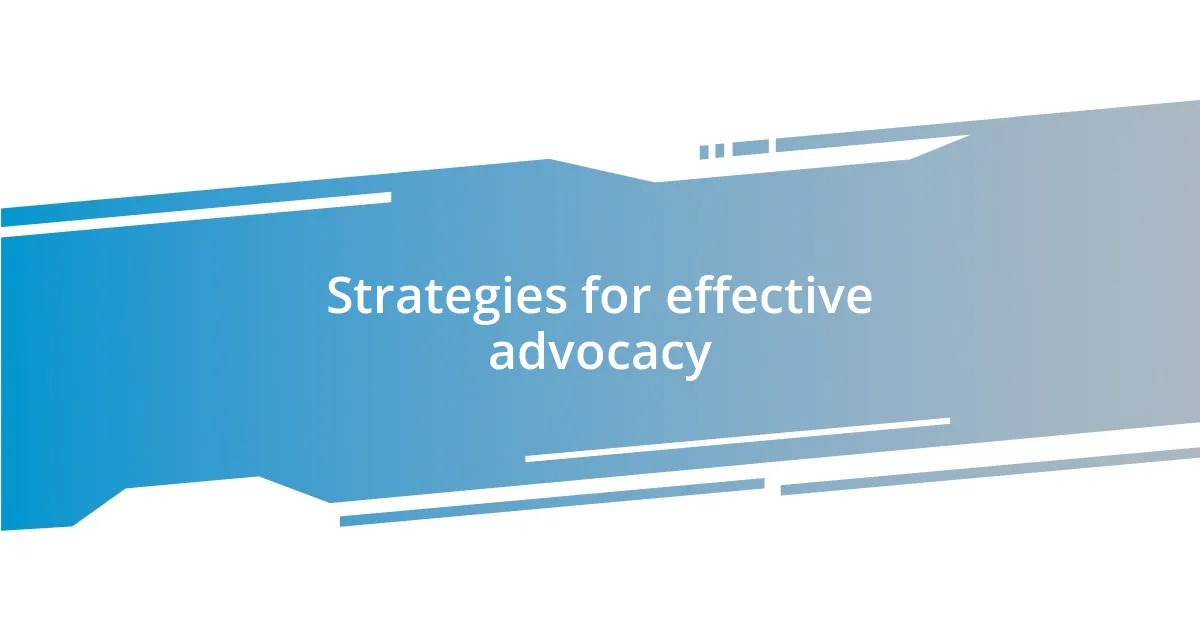
Strategies for effective advocacy
Advocacy for epilepsy research is not just about raising awareness; it’s about creating impactful strategies that resonate with both individuals and the broader community. I’ve found that storytelling plays a crucial role in this. During a town hall meeting, I shared an anecdote about a friend who had struggled with stigma after her first seizure. The way the audience leaned in, visibly moved, reminded me that real experiences—told openly—can bridge the gap between understanding and ignorance. Have you ever noticed how a heartfelt story can shift perspectives?
Another effective strategy I’ve employed is collaboration with local businesses and organizations. I remember one initiative where we teamed up with a café to host an epilepsy awareness event. For every coffee sold that day, a portion went to research funding. The community response was heartening. People began sharing their stories, piquing curiosity, and bringing the issue of epilepsy into everyday conversations. Partnerships like these make advocacy a collective effort; they elevate our voices and create a ripple effect that amplifies the message we’re all passionate about.
Lastly, I can’t stress enough the power of education in advocacy. I’ve attended workshops and webinars, learning more about the latest research and treatments. Sharing this knowledge is empowering. When I conducted an information session at a nearby school, the engagement from students astounded me. They asked questions that showed genuine interest, and it dawned on me how crucial it is to educate the next generation about epilepsy. After all, who better to carry the torch of awareness than the voices of tomorrow?
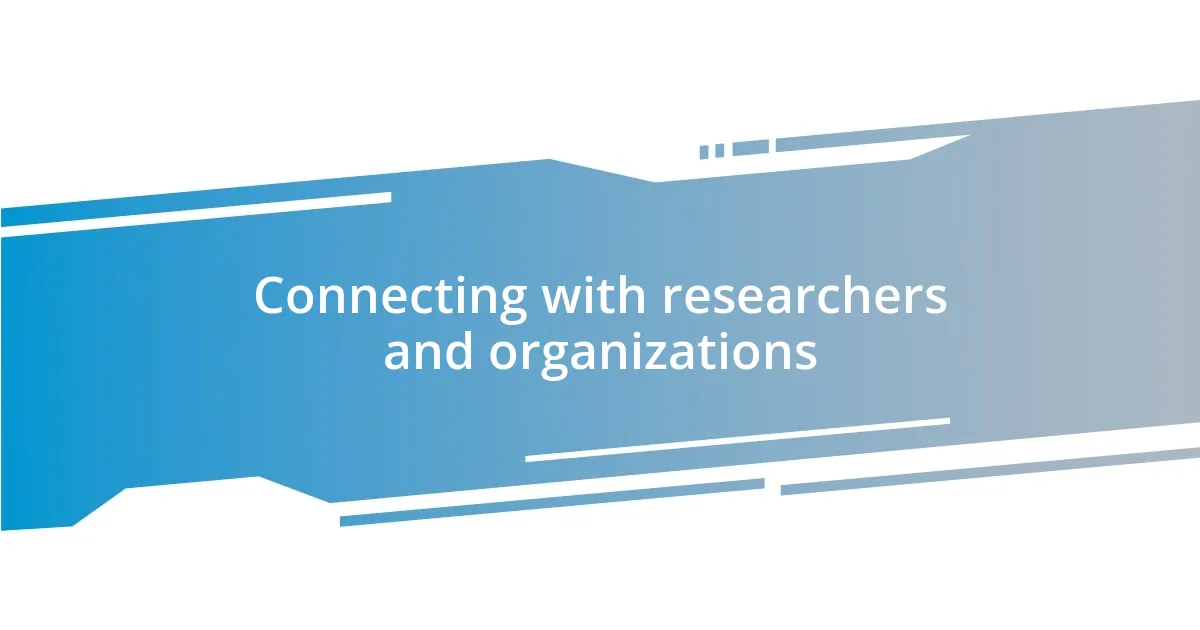
Connecting with researchers and organizations
Connecting with researchers and organizations has been a pivotal part of my journey. I still remember the first time I reached out to a local epilepsy research foundation. I felt a mix of excitement and apprehension as I drafted my email. Would they take me seriously? To my surprise, the director responded almost immediately, inviting me to a seminar where I could meet neurologists and researchers. That first conversation opened doors I never knew existed.
One encounter stands out vividly. At an epilepsy conference, I met a passionate researcher whose work focused on breakthrough treatments. I listened intently as she shared her insights on the impact of funding on research progress. I couldn’t help but think: how can we bridge the gap between lab work and real-life application? Every question I asked seemed to spark a deeper discussion about possibilities, igniting a sense of hope. I left that conference inspired, ready to foster relationships that could drive change.
Since then, I’ve made it a point to stay connected with these professionals. Setting up regular check-ins has allowed me to gain valuable insights into ongoing studies and share my advocacy experiences with them. By fostering these connections, I believe we can create a dynamic exchange—where researchers get firsthand accounts of patient experiences and advocates influence research priorities. Have you ever thought about how a simple conversation can lead to transformative change? In my experience, it’s in these moments that real progress begins.
